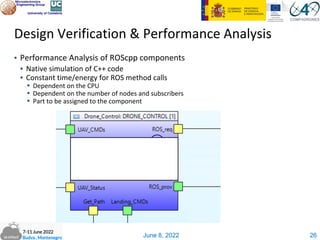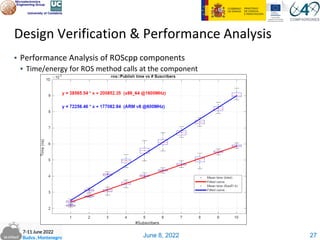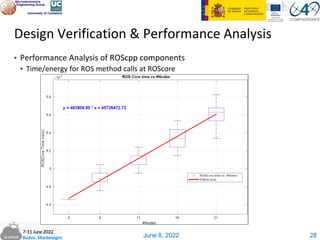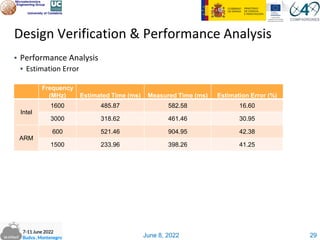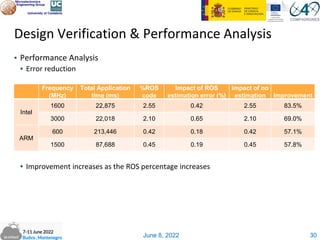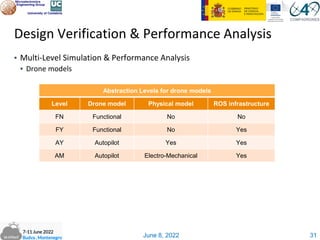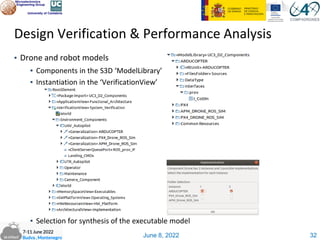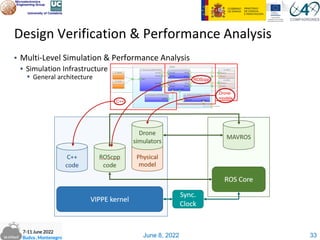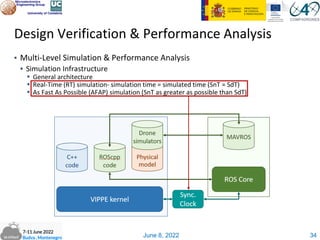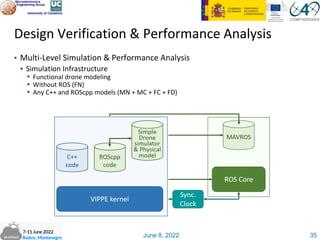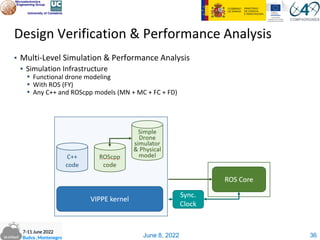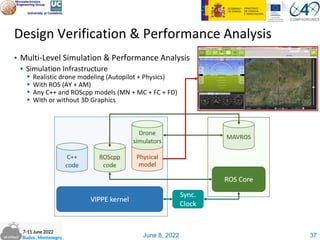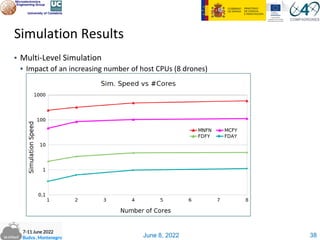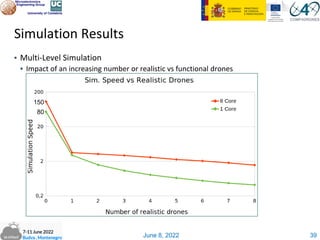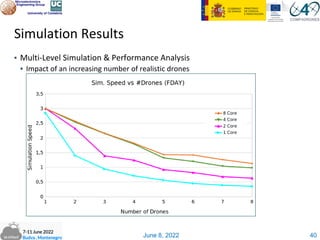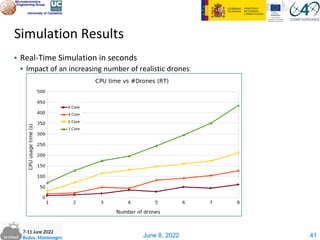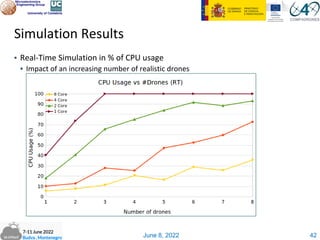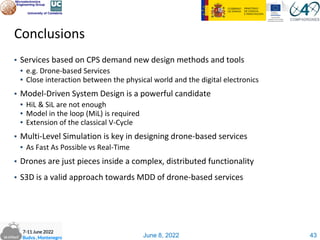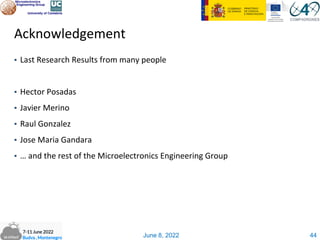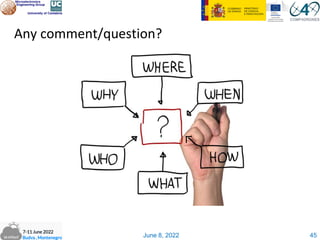Villar presentation.pdf
- 1. June 8, 2022 Eugenio Villar University of Cantabria Modeling, Design and Implementation of drone-based Services
- 2. June 8, 2022 Agenda Ō¢¬ Introduction Ō¢¬ Model-Driven Design of CPSoS Ō¢¬ Drone-based Services Ō¢¬ Design Verification and Performance Analysis Ō¢¬ Experimental Results Ō¢¬ Conclusions Ō¢¬ Demos Ō¢¬ ║▌║▌▀Żs can be found at: Ō¢¬ /EugenioVillar/ 2
- 3. June 8, 2022 N2 B N1 M A Introduction Ō¢¬ Model-Driven Design (MDD) Ō¢¬ High-abstraction level Ō¢¬ Mature SW engineering methodology Ō¢¬ UML Ō¢¬ Standard, any (user-defined) MoC, any language Ō¢¬ Natural way to capture system architecture 3 Ō¢¬ Semantic lacks Ō¢¬ Domain-specific profiles Ō¢¬ MetaMorph Ō¢¬ OpenSource, any (user-defined) MoC, language agnostic
- 4. June 8, 2022 Introduction Ō¢¬ Model-Driven Design (MDD) Ō¢¬ Abstraction of the platform Ō¢¬ SW development on APIs Ō¢¬ MWs, VMs, OSsŌĆ”. Ō¢¬ Simulation is not always an issue Ō¢¬ SiL & HiL Verification Ō¢¬ Performance is not key 4 M2C PCs Servers DCs HPCs Mobiles IoT compilation MWs VMs OSs Python Java C++ GO SwiftŌĆ”
- 5. June 8, 2022 Introduction Ō¢¬ State-of-the-Art in Simulation-Based MDD Ō¢¬ Matlab-Simulink Ō¢¬ Proprietary Ō¢¬ only one MoC, M language Ō¢¬ Application to UAVs Ō¢¬ Autopilot + Physics Ō¢¬ ROS toolbox Ō¢¬ AMeSIM/ANSyS Ō¢¬ Proprietary, only one MoC Ō¢¬ CoFluent Ō¢¬ Proprietary Ō¢¬ a few MoCs, C/C++ language Ō¢¬ Ptolemy II Ō¢¬ Academic, any MoC, C/C++ inside a Java block Ō¢¬ HEPSYCODE Ō¢¬ Academic, several MoCs, SystemC Ō¢¬ ŌĆ” 5 M2C MWs VMs OSs Python Java C++ GO SwiftŌĆ”
- 6. June 8, 2022 Introduction Ō¢¬ Embedded System Design (ESD) & Electronic System-Level Design (ESL) Ō¢¬ Model of the platform Ō¢¬ At different abstraction levels Ō¢¬ Platform-based HW/SW co-design Ō¢¬ Simulation is key Ō¢¬ At different abstraction levels Ō¢¬ Performance is key Ō¢¬ Cyber-Physical interaction Ō¢¬ Real-Time Systems 6 P&R C++ SystemC VHDL/VerilogŌĆ” SoC FPGAs Boards NoC HW accel. I/O Busses GPUs CPUs MWs VMs OSs HLS/RTL synthesis compilation
- 7. June 8, 2022 Introduction Ō¢¬ Services provided on computing platforms of many kind Ō¢¬ Programming the Internet of Everything Ō¢¬ In close interaction with the physical world => CPSoS-IoT Ō¢¬ Full abstraction of the computing platform is no longer possible 7
- 8. June 8, 2022 Introduction Ō¢¬ Gap between MDD & ESD/ESL Ō¢¬ S3D: Single-Source System Design Ō¢¬ Linking MDD with ESD/ESL Ō¢¬ Simulating the PSM Ō¢¬ At different abstraction levels Ō¢¬ Estimating performance Ō¢¬ Depending on the HW Platform Ō¢¬ Automatic generation of the executable models Ō¢¬ Design-Space Exploration Python Java C++ GO SwiftŌĆ” SoC FPGAs Boards NoC HW accel. I/O Busses GPUs CPUs MWs VMs OSs ?? Design Gap 8
- 9. June 8, 2022 HW/SW Platform Architectural Mappings C/ C++ Scenarios PIM (App) M2T Tools SW Synthesis (mSSYN) Simulation model Synthesis (mSSYN) VIPPE Introduction Ō¢¬ S3D: System Modeling & Simulation 9
- 10. June 8, 2022 HW/SW Platform Architectural Mapping C/ C++ Scenarios PIM (App) M2T Tools SW Synthesis (eSSYN) SMP Nodes GPUs HW Accelerators Application SW Introduction Ō¢¬ S3D: HW/SW Synthesis 10
- 11. June 8, 2022 Introduction Ō¢¬ S3D: Design-Space Exploration Ō¢¬ Linking MDD with ESL Python Java C++ GO SwiftŌĆ” SoC FPGAs Boards NoC HW accel. I/O Busses GPUs CPUs MWs VMs OSs 11
- 12. June 8, 2022 Introduction Ō¢¬ S3D: Programming the Internet of Everything Ō¢¬ Services provided on heterogeneous computing platforms of many kind Ō¢¬ Impact on functional and non-functional properties of the execution platform HW Synthesis SW Synthesis (RT)OS, Runtime,ŌĆ” Corba, TCP/IP, MPI, MCAPI,ŌĆ” ForTran, Python, Java, HTML5, C/C++,ŌĆ” Concerns Performance, safety, cost, security, size, ŌĆ” Schedulability Analysis Simulation Verification Performance Analysis Design-Space Exploration Optimization Service UML CPSoS DSL UML CPSoS DSL 12
- 13. June 8, 2022 Model-Driven Design of Cyber-Physical SoS Ō¢¬ Traditional V-Cycle for Mechatronic Systems Ō¢¬ Design & Analyze Ō¢¬ Develop (Platform-Dependent) Ō¢¬ Verify 13
- 14. June 8, 2022 Model-Driven Design of Cyber-Physical SoS Ō¢¬ New Validation/Verification V-Cycle Ō¢¬ Reusability Ō¢¬ Simulation-based Analysis & Design Ō¢¬ Design-Space Exploration Ō¢¬ Performance Analysis Ō¢¬ Architectural mapping 14
- 15. June 8, 2022 Model-Driven Design of Cyber-Physical SoS Ō¢¬ System Design & Validation Ō¢¬ System Interface Ō¢¬ Domain & System Requirements Ō¢¬ Functional Specification Ō¢¬ Input/Output Rates and Delays Ō¢¬ Test-Bench Development Ō¢¬ Minimal Functionality Ō¢¬ System Validation 15
- 16. June 8, 2022 Ō¢¬ CPS: Digital Behavior in a Physical World Ō¢¬ System Model (Specification) Ō¢¬ The implementation is as good as similar to the model Ō¢¬ Environment Model Ō¢¬ The model is as good as similar to reality Ō¢¬ Close-loop behavior can be extremely difficult to model Model-Driven Design of Cyber-Physical SoS 16
- 17. June 8, 2022 Model-Driven Design of Cyber-Physical SoS Ō¢¬ Mechanical & HW/SW Design & Validation Ō¢¬ Sub-System & Component Interface Ō¢¬ Sub-System & Component Requirements Ō¢¬ Input/Output Rates and Delays Ō¢¬ Minimal Sub-System & Component Functionality => System Validation Ō¢¬ Reusability
- 18. June 8, 2022 Model-Driven Design of Cyber-Physical SoS Ō¢¬ ROS Ō¢¬ De-facto standard for robot applications Ō¢¬ ROS Infrastructure Ō¢¬ ROS nodes Ō¢¬ Processes that perform a certain computation Ō¢¬ ROS Master (Core) Ō¢¬ Nodes registration Ō¢¬ Communication manager 18 Client-Server (RPC) Publish-Suscriber
- 19. June 8, 2022 Model-Driven Design of Cyber-Physical SoS Ō¢¬ Platform-Based Design Ō¢¬ POSIX API Ō¢¬ ROS API 19
- 20. June 8, 2022 VIPPE Scheduler Host Execution Platform Ubuntu 18.04 Intel i5-34700 x86-64 Process 1 Process 2 Process 3 Model-Driven Design of Cyber-Physical SoS Ō¢¬ Platform-Based Simulation Ō¢¬ POSIX API Ō¢¬ ROS API 20
- 21. June 8, 2022 Model-Driven Design of Cyber-Physical SoS Ō¢¬ Drone-Independent ROS Interface Ō¢¬ Extensible to robots with similar functionality 21
- 22. June 8, 2022 Model-Driven Design of Cyber-Physical SoS Ō¢¬ Drone-Independent ROS Interface Ō¢¬ Reusable ROS code Ō¢¬ Code length reduction Ō¢¬ Decrease in simulation speed 22 Reduction in program length Drone Drone-specific code (LoCs) CoDIn (LoCs) Reduction (%) Ardupilot 343 233 32.07 Px4 357 34.73 Reduction in simulation speed Drone Drone-specific code (s/s) CoDIn (s/s) Reduction (%) Ardupilot 1.9 1,85 2,6
- 23. June 8, 2022 Ō¢¬ S3D components in a drone-based service Ō¢¬ C++ components Ō¢¬ ROScpp components Ō¢¬ Drone and robot models Design Verification & Performance Analysis C++ ROScpp Drone models 23
- 24. June 8, 2022 Ō¢¬ Multi-Level Simulation & Performance Analysis Ō¢¬ C++ and ROScpp components Ō¢¬ Simulation of ROScpp components without the (slow) ROS infrastructure Ō¢¬ Functional ROS Ō¢¬ Direct links among publishers and subscribers Design Verification & Performance Analysis Abstraction Levels for C++ & ROS cpp components Level Code Timing/Energy ROS infrastructure MN Minimal No Yes/No MC Minimal Constant FC Full code Constant FD Full code Data-dependent 24
- 25. June 8, 2022 Ō¢¬ Native Simulation: Flaxibility + accuracy ŌĆ” Overflow = 0; s = 1L; for (i = 0; i < L_subfr; i++) { Carry = 0; s = L_macNs(s, xn[i], y1[i]); if (Overflow != 0) { break; }} if (Overflow == 0) { exp_xy = norm_l(s); if (exp_xy<=0) xy = round(L_shr (s, -exp_xy)); else xy = round(L_shl (s, exp_xy)); } mutex_lock(mutex_name); ŌĆ” Global variable int Sim_Time = 0; Sim_Time += TB(); Sim_Time += TB(); Sim_Time += TB(); Sim_Time += TB(); Sim_Time += TB(); Sim_Time += TB(); wait included TB() is a function of # of binary instructions type of instructions # of cache misses frequency ŌĆ” even data dependencies Sim_Time += TSYS(); TSYS() is a function of preemptions conflicts in the busŌĆ” Design Verification & Performance Analysis 25
- 26. June 8, 2022 Native Simulation Ō¢¬ Performance Analysis of ROScpp components Ō¢¬ Native simulation of C++ code Ō¢¬ Constant time/energy for ROS method calls Ō¢¬ Dependent on the CPU Ō¢¬ Dependent on the number of nodes and subscribers Ō¢¬ Part to be assigned to the component Design Verification & Performance Analysis 26
- 27. June 8, 2022 Ō¢¬ Performance Analysis of ROScpp components Ō¢¬ Time/energy for ROS method calls at the component Design Verification & Performance Analysis 27
- 28. June 8, 2022 Ō¢¬ Performance Analysis of ROScpp components Ō¢¬ Time/energy for ROS method calls at ROScore Design Verification & Performance Analysis 28
- 29. June 8, 2022 Ō¢¬ Performance Analysis Ō¢¬ Estimation Error Design Verification & Performance Analysis 29 Frequency (MHz) Estimated Time (ms) Measured Time (ms) Estimation Error (%) Intel 1600 485.87 582.58 16.60 3000 318.62 461.46 30.95 ARM 600 521.46 904.95 42.38 1500 233.96 398.26 41.25
- 30. June 8, 2022 Ō¢¬ Performance Analysis Ō¢¬ Error reduction Ō¢¬ Improvement increases as the ROS percentage increases Design Verification & Performance Analysis 30 Frequency (MHz) Total Application time (ms) %ROS code Impact of ROS estimation error (%) Impact of no estimation Improvement Intel 1600 22,875 2.55 0.42 2.55 83.5% 3000 22,018 2.10 0.65 2.10 69.0% ARM 600 213,446 0.42 0.18 0.42 57.1% 1500 87,688 0.45 0.19 0.45 57.8%
- 31. June 8, 2022 Ō¢¬ Multi-Level Simulation & Performance Analysis Ō¢¬ Drone models Design Verification & Performance Analysis Abstraction Levels for drone models Level Drone model Physical model ROS infrastructure FN Functional No No FY Functional No Yes AY Autopilot Yes Yes AM Autopilot Electro-Mechanical Yes 31
- 32. June 8, 2022 Ō¢¬ Drone and robot models Ō¢¬ Components in the S3D ŌĆśModelLibraryŌĆÖ Ō¢¬ Instantiation in the ŌĆśVerificationViewŌĆÖ Ō¢¬ Selection for synthesis of the executable model Design Verification & Performance Analysis 32
- 33. June 8, 2022 Ō¢¬ Multi-Level Simulation & Performance Analysis Ō¢¬ Simulation Infrastructure Ō¢¬ General architecture Design Verification & Performance Analysis 33
- 34. June 8, 2022 Ō¢¬ Multi-Level Simulation & Performance Analysis Ō¢¬ Simulation Infrastructure Ō¢¬ General architecture Ō¢¬ Real-Time (RT) simulation- simulation time = simulated time (SnT = SdT) Ō¢¬ As Fast As Possible (AFAP) simulation (SnT as greater as possible than SdT) Design Verification & Performance Analysis 34
- 35. June 8, 2022 Ō¢¬ Multi-Level Simulation & Performance Analysis Ō¢¬ Simulation Infrastructure Ō¢¬ Functional drone modeling Ō¢¬ Without ROS (FN) Ō¢¬ Any C++ and ROScpp models (MN + MC + FC + FD) Design Verification & Performance Analysis 35
- 36. June 8, 2022 Ō¢¬ Multi-Level Simulation & Performance Analysis Ō¢¬ Simulation Infrastructure Ō¢¬ Functional drone modeling Ō¢¬ With ROS (FY) Ō¢¬ Any C++ and ROScpp models (MN + MC + FC + FD) Design Verification & Performance Analysis 36
- 37. June 8, 2022 Ō¢¬ Multi-Level Simulation & Performance Analysis Ō¢¬ Simulation Infrastructure Ō¢¬ Realistic drone modeling (Autopilot + Physics) Ō¢¬ With ROS (AY + AM) Ō¢¬ Any C++ and ROScpp models (MN + MC + FC + FD) Ō¢¬ With or without 3D Graphics Design Verification & Performance Analysis 37
- 38. June 8, 2022 Ō¢¬ Multi-Level Simulation Ō¢¬ Impact of an increasing number of host CPUs (8 drones) Simulation Results 38
- 39. June 8, 2022 Ō¢¬ Multi-Level Simulation Ō¢¬ Impact of an increasing number or realistic vs functional drones Simulation Results 150 80 39
- 40. June 8, 2022 Simulation Results Ō¢¬ Multi-Level Simulation & Performance Analysis Ō¢¬ Impact of an increasing number of realistic drones 40
- 41. June 8, 2022 Ō¢¬ Real-Time Simulation in seconds Ō¢¬ Impact of an increasing number of realistic drones Simulation Results 41
- 42. June 8, 2022 Simulation Results Ō¢¬ Real-Time Simulation in % of CPU usage Ō¢¬ Impact of an increasing number of realistic drones 42
- 43. June 8, 2022 Conclusions Ō¢¬ Services based on CPS demand new design methods and tools Ō¢¬ e.g. Drone-based Services Ō¢¬ Close interaction between the physical world and the digital electronics Ō¢¬ Model-Driven System Design is a powerful candidate Ō¢¬ HiL & SiL are not enough Ō¢¬ Model in the loop (MiL) is required Ō¢¬ Extension of the classical V-Cycle Ō¢¬ Multi-Level Simulation is key in designing drone-based services Ō¢¬ As Fast As Possible vs Real-Time Ō¢¬ Drones are just pieces inside a complex, distributed functionality Ō¢¬ S3D is a valid approach towards MDD of drone-based services 43
- 44. June 8, 2022 Acknowledgement Ō¢¬ Last Research Results from many people Ō¢¬ Hector Posadas Ō¢¬ Javier Merino Ō¢¬ Raul Gonzalez Ō¢¬ Jose Maria Gandara Ō¢¬ ŌĆ” and the rest of the Microelectronics Engineering Group 44
- 45. June 8, 2022 Any comment/question? 45

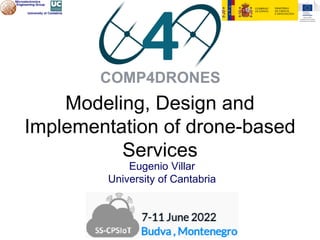
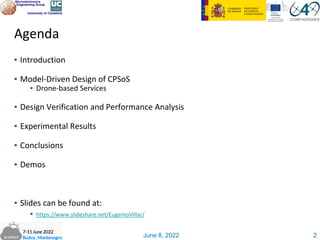
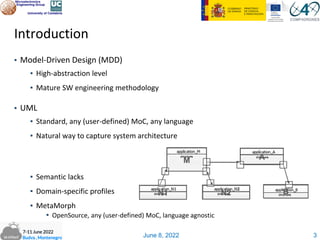
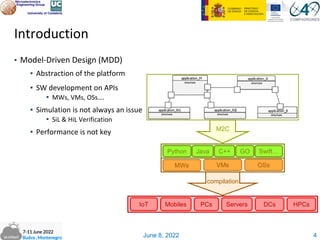
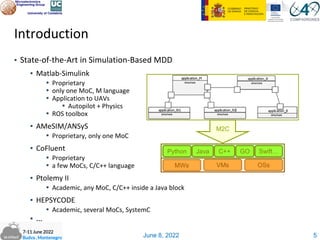
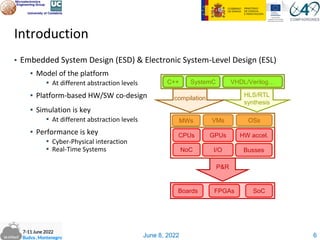
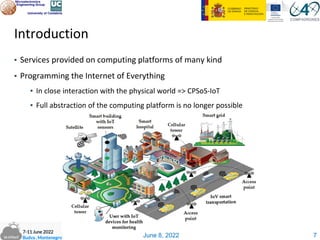
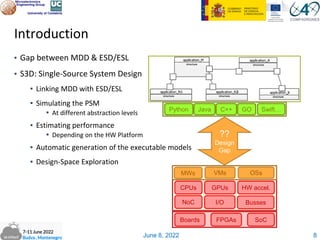
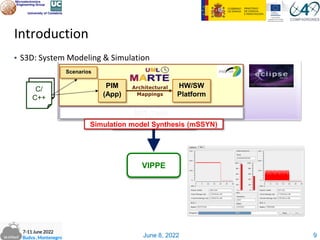
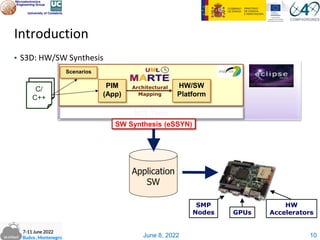
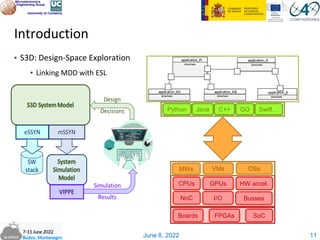
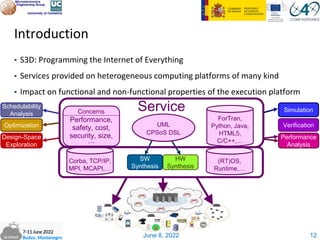
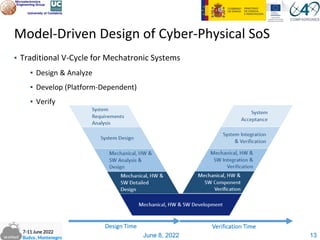
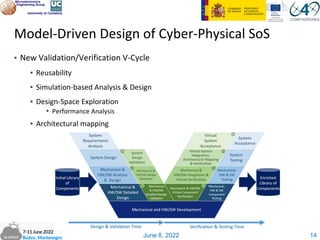
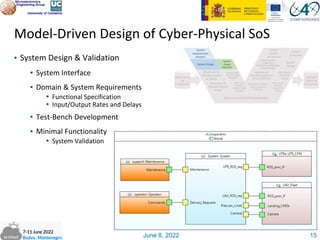
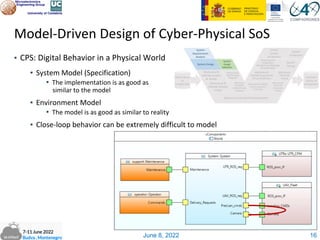
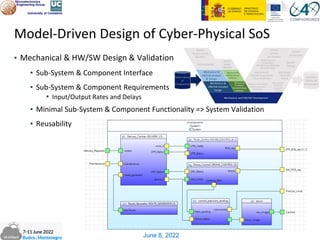

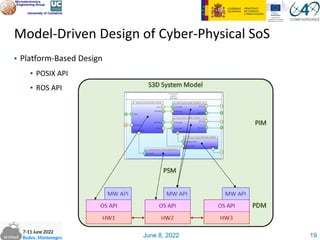
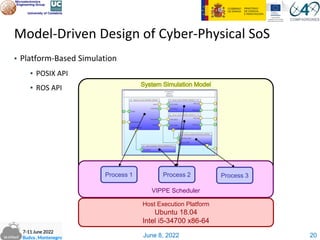
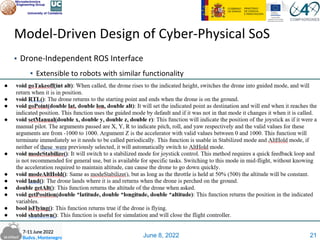
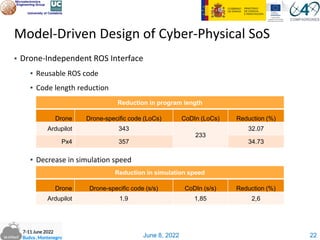
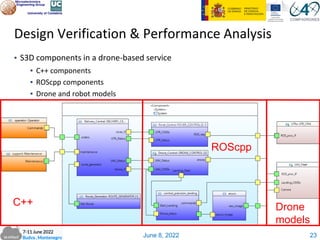
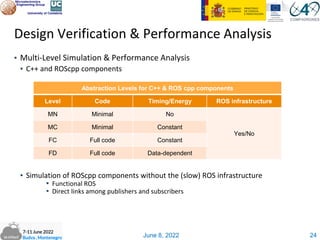
![June 8, 2022
Ō¢¬ Native Simulation: Flaxibility + accuracy
ŌĆ”
Overflow = 0;
s = 1L;
for (i = 0; i < L_subfr; i++) {
Carry = 0;
s = L_macNs(s, xn[i], y1[i]);
if (Overflow != 0) {
break; }}
if (Overflow == 0) {
exp_xy = norm_l(s);
if (exp_xy<=0)
xy = round(L_shr (s, -exp_xy));
else
xy = round(L_shl (s, exp_xy)); }
mutex_lock(mutex_name);
ŌĆ”
Global variable
int Sim_Time = 0;
Sim_Time += TB();
Sim_Time += TB();
Sim_Time += TB();
Sim_Time += TB();
Sim_Time += TB();
Sim_Time += TB();
wait included
TB() is a function of
# of binary instructions
type of instructions
# of cache misses
frequency
ŌĆ”
even
data dependencies
Sim_Time += TSYS();
TSYS() is a function of
preemptions
conflicts in the busŌĆ”
Design Verification & Performance Analysis
25](https://image.slidesharecdn.com/villarpresentation-220608140733-9a6230f5/85/Villar-presentation-pdf-25-320.jpg)
